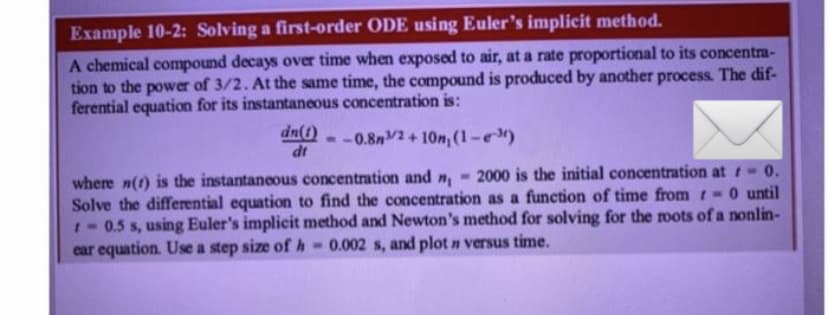A chemical compound decays over time when exposed tion to the power of 3/2. At the same time, the compound is produced by another process. The dif- ferential equation for its instantaneous concentration is: dn(1)-0.8n/2+10n, (1-³) where n() is the instantaneous concentration and n, 2000 is the initial concentration at 0. Solve the differential equation to find the concentration as a function of time from r-0 until - 0.5 s, using Euler's implicit method and Newton's method for solving for the roots of a nonlin- car equation. Use a step size of h 0.002 s, and plot n versus time. dt
A chemical compound decays over time when exposed tion to the power of 3/2. At the same time, the compound is produced by another process. The dif- ferential equation for its instantaneous concentration is: dn(1)-0.8n/2+10n, (1-³) where n() is the instantaneous concentration and n, 2000 is the initial concentration at 0. Solve the differential equation to find the concentration as a function of time from r-0 until - 0.5 s, using Euler's implicit method and Newton's method for solving for the roots of a nonlin- car equation. Use a step size of h 0.002 s, and plot n versus time. dt
Algebra & Trigonometry with Analytic Geometry
13th Edition
ISBN:9781133382119
Author:Swokowski
Publisher:Swokowski
Chapter5: Inverse, Exponential, And Logarithmic Functions
Section: Chapter Questions
Problem 18T
Related questions
Question

Transcribed Image Text:Example 10-2: Solving a first-order ODE using Euler's implicit method.
A chemical compound decays over time when exposed to air, at a rate proportional to its concentra-
tion to the power of 3/2. At the same time, the compound is produced by another process. The dif-
ferential equation for its instantaneous concentration is:
dn(1) --0.8m/2+10n, (1-³)
dt
where n(t) is the instantaneous concentration and n - 2000 is the initial concentration at 0.
Solve the differential equation to find the concentration as a function of time from -0 until
- 0.5 s, using Euler's implicit method and Newton's method for solving for the roots of a nonlin-
car equation. Use a step size of h= 0.002 s, and plot n versus time.
Expert Solution
This question has been solved!
Explore an expertly crafted, step-by-step solution for a thorough understanding of key concepts.
Step by step
Solved in 4 steps with 4 images

Recommended textbooks for you

Algebra & Trigonometry with Analytic Geometry
Algebra
ISBN:
9781133382119
Author:
Swokowski
Publisher:
Cengage

Algebra & Trigonometry with Analytic Geometry
Algebra
ISBN:
9781133382119
Author:
Swokowski
Publisher:
Cengage